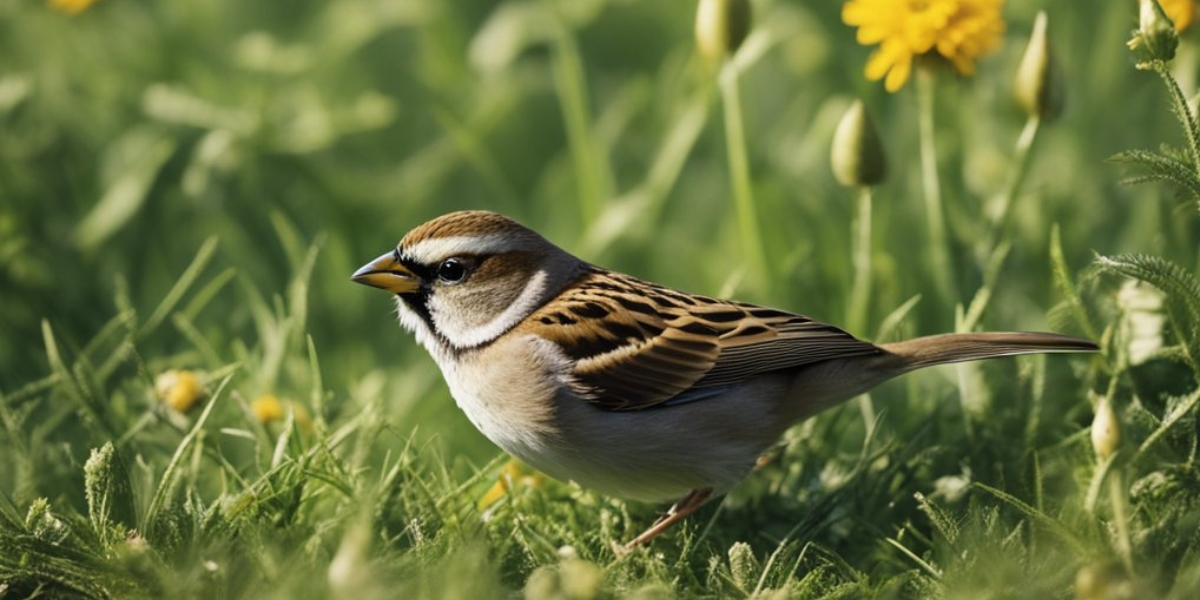Sparrows are one of the most common and widespread bird species, found on every continent except Antarctica. But what do these ubiquitous little birds eat that fuels their global proliferation? As it turns out, sparrows maintain a diverse diet that allows them to adapt and thrive across diverse habitats. Their dietary flexibility provides great insight into the feeding behaviors and nutritional requirements of small seed-eating birds.
Introduction
Sparrows belong to the taxonomic family Passeridae, comprising small-bodied birds with stout, cone-shaped bills adapted for cracking and hulling seeds. Sparrows primarily eat plant material and small invertebrates, with their diet varying based on ecosystem, season, and species. Understanding sparrow nutritional requirements and food sources helps us better support their populations.
Types of Food Sparrow Birds Eat
Sparrows forage on a broad range of food types to meet their nutritional needs:
Seeds
Seeds comprise the bulk of most sparrow species’ diets. Favored varieties include:
- Grains – Sparrows hull oats, wheat, sorghum, millet, and rice grains found in fields.
- Sunflower seeds – A preferred food at bird feeders, providing fat and protein.
- Hemp and thistle seeds – Offered at feeders or foraged from dried flower heads.
- Grasses and sedges – Sparrows eat nutrient-rich seeds of wild grasses and sedge plants.
Seeds deliver carbohydrates, healthy fats, and protein vital to sparrow metabolism and energy.
Insects
Insects offer essential protein, fat, and minerals. Sparrows prey on:
- Caterpillars
- Beetles
- Ants
- Grasshoppers
- Crickets
- Spiders
- Flies
- Aphids
- Mosquitos
- Butterfly/moth larvae
They capture insects from foliage or the ground by gleaning, hovering, or stalking.
Fruits and Berries
Fruits/berries provide sugars, fiber, vitamins:
- Blackberries
- Elderberries
- Strawberries
- Blueberries
- Apples
- Cherries
Fruit ripens in summer/fall when insects are scarce, offering backup nutrition.
Nuts and Seeds
Nuts deliver protein and healthy fats:
- Acorns
- Pecans
- Peanuts
- Walnuts
- Almonds
Sparrows pry nutmeat from shells or access cracked nuts from squirrels.
Other Foods
Occasionally, sparrows also consume:
- Tree sap – For sugars
- Nectar – From flowers
- Grit/shells – For digestion
- Bread – At bird feeders
This boosts mineral intake.
Sparrow Birds’ Feeding Habits
Sparrows have adapted feeding patterns and behaviors to maximize food acquisition:
Feeding Cycles
- Dawn peak – Intense feeding after overnight fast to replenish energy.
- Daytime foraging – More intermittently while balancing other activities.
- Dusk peak – Stock up before night.
Flocking and Social Feeding
- Foraging in loose flocks provides safety from predators.
- Social facilitation encourages competition and food discovery.
- Dominant birds often control best food sources.
Ground Scratching
- Sparrows scatter scratch to unearth seeds, nuts, and invertebrates.
- Rare backward scratching allows scanning for threats.
Frequent Hopping
- Sparrows take more food steps per minute compared to other birds.
- Hopping lets them cover ground and sample food unpredictably to avoid predation.
Food Caching
- Sparrows cache excess food in scattered locations for retrieval later.
- Caching helps meet high energy needs in cold months.
- Cached items include seeds, nuts, and small invertebrates.
Importance of Diet in Sparrow Birds’ Lives
Nutrition crucially supports sparrow life processes:
Energy Needs
- Sparrows have high metabolism and expend energy rapidly.
- Frequent feeding provides calories to fuel their active lifestyles.
Growth and Development
- A protein-rich diet supplies amino acids needed for muscular growth and feather production.
- Plentiful calcium enables bone development.
- Carotenoids from seeds and insects ensure colorful plumage.
Breeding and Reproduction
- Nutrients accumulated pre-breeding help form eggs.
- Ample food supplies are required for the female to produce clutch after clutch.
- Nestlings need calcium and protein to grow.
Survival During Migration
- Fattening up pre-migration provides energy reserves.
- Caching food supplies supports migratory stopovers when food is scarce.
Cold Weather Survival
- High-calorie foods like seeds give energy to maintain body heat.
- Cached food provides backup when foraging is limited by snow cover.
Disease Resistance
- Vitamin and mineral intake boosts immune function.
- Adequate protein helps resist parasitic infections.
Adaptations Based on Habitat
Sparrow dietary adaptations reflect the food resources in their habitats:
Grassland Species
Grassland sparrows like Vesper and Savannah Sparrows:
- Consume small grass and weed seeds of open habitats.
- Pluck grasshoppers and other insects from stalks and soil.
- Excavate small seeds from dried seed heads of plants.
Woodland Species
Forest-dwelling White-throated Sparrows:
- Hull small tree seeds like pine, maple and beech.
- Probe leaf litter for beetles, millipedes, and fungi.
- Pluck larvae and insects from bark and branches.
Wetland Species
Marsh inhabitants like Swamp Sparrows:
- Weave through reeds to grab invertebrates.
- Consume millet-like seeds of sedges and grasses.
- Waddle on mud to peck at aquatic insect larvae.
Urban Adaptations
House Sparrows flourishing in cities:
- Scavenge crumbs and waste grains from sidewalks.
- Pick insects and spiders from building cracks and eaves.
- Consume bread, seed mixes, and suet at bird feeders.
Unique Sparrow Foraging Adaptations
Sparrows have special physical and behavioral adaptations to help them find and eat food:
Conical Beaks
- Allow hulling tough seed coatings and extracting insects from crevices.
- Sharp upper mandible tears food.
- Specialized palate assists in manipulating seeds.
Strong Scratching Feet
- Long hind claws rake and scatter debris to uncover food.
- Grasping toes enable perching while eating.
Expansive Vision
- Sparrows have near 360° vision to spot food and threats.
- Binocular vision helps judge distances when striking at food.
Food Caching Instincts
- Impulse to cache surplus food helps ensure future intake.
- Spatial memory maps cache locations for recovery.
Safety Through Flocks
- Foraging socially offers protection from predators.
- Information sharing helps individuals locate new food patches.
Threats to Sparrow Food Supplies
Several factors can reduce sparrow food availability:
Agricultural Intensification
- Plowing and herbicide use eliminates weedy foraging grounds and wipes out insects.
- Loss of crop field margins and hedgerows removes vital seed sources.
Invasive Species
- Some invasive plants crowd out native seed-producing vegetation.
- House Sparrows often outcompete native sparrows for food resources.
Development and Urbanization
- Building expansion eliminates sparrow-foraging grounds.
- Pesticides reduce insect availability in suburbs.
Severe Weather
- Drought kills plants and reduces seed crops and insect numbers.
- Deep snow limits winter food access.
Climate Change
- Altered seasons impact fruiting patterns and insect lifecycles.
- Adding artificial food sources like bird feeders can help compensate for some food loss from the above threats. But protecting native vegetation remains crucial.
People Also Read:
Conclusion
Sparrows have adapted as dietary generalists, exploiting diverse food resources across habitats worldwide. Their flexible nutrition allows expansion into new ecosystems. Careful study of sparrow diets continues to provide ecological insights into the adaptations and resource needs of small seed-eating songbirds. Supporting sparrow populations requires protecting the native plants, insects, and unmaintained wilderness areas that enable their varied diet. Their foraging activities, in turn, help propagate diverse flora through seed dispersal. Appreciating the role of nutrition in sparrows’ lives deepens our understanding of their critical environmental ties.
Frequently Asked Questions
Q1: How much do sparrows need to eat each day?
A: Sparrows have very high metabolisms. They may consume up to 30% of their body weight daily. This equals about 3-6 grams of seeds daily for most sparrow species.
Q2: Where do sparrows get their water needs?
A: Sparrows get most of their water from the moist foods they eat, like seeds, fruits, and insects. They also drink rainwater collected in leaves and puddles. Having water sources like bird baths available provides supplementation.
Q3: Do sparrows only eat at bird feeders?
A: No, bird feeders just supplement natural foods. Sparrows spend most foraging time scouring wild vegetation for diverse nutrients. Feeders alone wouldn’t provide a complete diet.
Q4: How do sparrows help ecosystems through their feeding habits?
A: Sparrows disperse seeds widely through droppings as they forage, helping propagate native plants. Their insect consumption helps control pest populations and provides manure fertilization.
Q5: Which sparrow species has the most specialized diet?
A: The Saltmarsh Sparrow, found only in coastal marshes of the eastern U.S., relies almost exclusively on tidal marsh plant seeds like glassworts and seaside grasses to survive.

